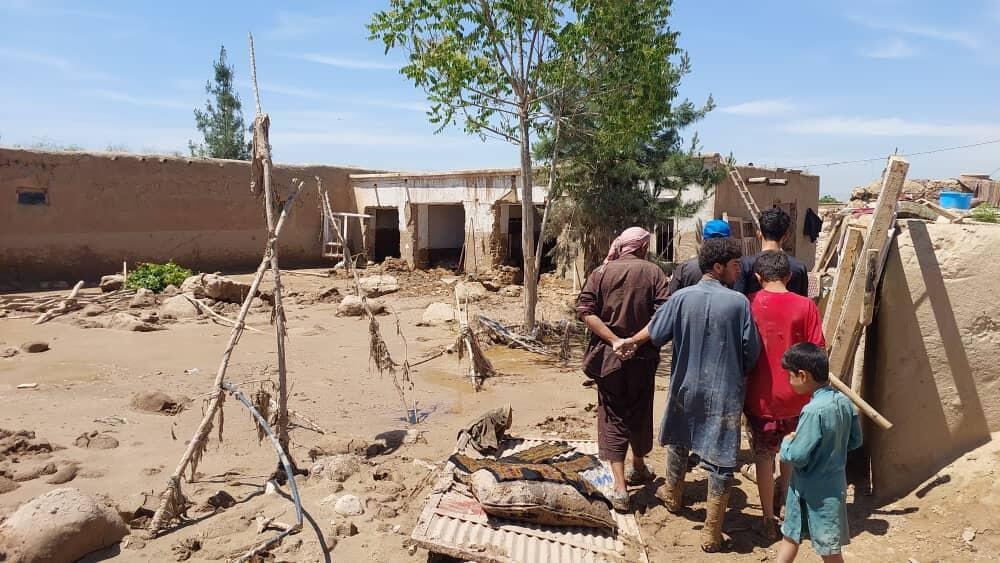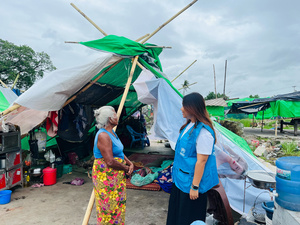Climate crisis fuels flooding and deepens displacement

Climate crisis fuels flooding and deepens displacement
An aerial view of the flooded Monument to the Azoreans in Porto Alegre, Brazil.
The majority of the world’s refugees and displaced people live in highly climate-vulnerable situations where they are exposed to increasingly frequent and extreme weather events. Here is the why, where, who, what and how of the ongoing catastrophic flooding:
Why… is flooding on the increase?
A hotter global climate, with greater fluctuations in the weather, is increasing the risk of flooding. With heavy rainfall set to become more intense in many regions of the world, more frequent and major flooding is expected. Unprecedented events are becoming more likely, whether seasonal river flooding linked to snowmelt and changing land and water use by populations, or coastal flooding due to the compounding effect of storm surges, extreme rainfall brought by tropical cyclones and hurricanes, and heavy river flows.
Climate-related displacement hits the poorest and most vulnerable hardest, including refugees and internally displaced people who have already been forced to flee their homes because of conflicts and other crises.
Floods and the disasters that follow are often the result of a combination of interconnected processes, including deforestation and land use change that destabilize soil, human infrastructure that impedes natural drainage, weather patterns, and changes in human settlement with more people living in flood-prone areas. As a result, nature’s ability to absorb torrential downpours is weakened as the environment is degraded by human actions and the intensity of rainfall strengthens.

People walk along a road protected by dikes through flood waters near Benitu, South Sudan.
Where… is the flooding happening right now?
- In Afghanistan, hundreds of people have been killed by flooding in May that began in the northeast of the country before sweeping through central regions heading southward. Thousands of homes have been damaged or destroyed, displacing families. Across the country, bridges, roads, health facilities and schools have been damaged or their services disrupted, and agricultural fields, orchards, and grazing land have been affected. More heavy rain is expected in central and southern regions in the coming week.

Residents in Baghlan-e-Jadid district assess the damage caused by recent flooding in Afghanistan's northeastern Baghlan province.
- In Brazil, floods in the southern Rio Grande do Sul state in May have killed at least 161 people and affected more than 2.34 million. Among those affected are 43,000 refugees and others in need of international protection, including Venezuelans and Haitians. Around 90 per cent of municipalities have been affected by the heavy rains, with 582,000 forced to flee their homes.
- In East Africa, heavy El Niño-rains since March have afflicted a fragile developing region that hosts 4.6 million refugees across 11 countries. More than 637,000 people have been affected, with an estimated 234,000 of them displaced. The worst of the flooding has been in Kenya, Burundi, Somalia and Tanzania. In Kenya, 210 people have been killed, and 20,000 refugees have been displaced from the Dadaab refugee camps, while in Burundi around 10 per cent of farmland has been destroyed.
Who… is affected by the floods?
Climate change exacerbates the risk of displacement. The past decade saw on average 24 million displacements caused by disasters every year: 92 per cent were triggered by weather-related hazards (with floods accounting for nearly half of these), and the rest by geophysical hazards, such as earthquakes. In 2023, floods caused 9.8 million displacements.
Displacement and climate vulnerability are intertwined, especially in conflict-affected settings: 60 per cent of the world’s 114 million refugees and people internally displaced by conflict are in countries on the front lines of climate change, exacerbating the protection needs and risks for displaced people and contributing to new, onward, and protracted displacement.

As a result, it is the most vulnerable people in the world who are disproportionately affected by flooding and other climate shocks and stresses. This includes refugees and displaced people who lack basic resources, permanent shelters and robust social safety nets, and who may be excluded from government measures to strengthen flood preparedness and resilience. Host communities are also hit hard, especially those living in informal settlements and shantytowns in flood-prone areas where infrastructure such as drainage and wastewater treatment is often inadequate, and homes flimsy.
What… is UNHCR doing to respond?
Because of its global presence, partnerships, and emergency preparedness, UNHCR is well-placed to prevent, prepare for, and respond to the protection and humanitarian consequences of floods in displacement settings and, when requested by governments, to extend assistance to all people displaced by floods.
In April 2024, UNHCR announced its campaign to raise $100 million for a new Climate Resilience Fund. UN High Commissioner for Refugees Filippo Grandi said, “The impacts of climate change are only becoming more devastating, increasingly exacerbating conflict, destroying livelihoods and, ultimately, triggering displacement.”
The fund will address these challenges head-on by advancing climate resilience initiatives and supporting communities most vulnerable to climate threats, reducing the environmental impact of emergency responses, providing sustainable resources and clean energy for refugees and displaced people, and helping equip them to withstand future climate shocks.

A UNHCR staff member distributes emergency items to refugees displaced by floods in Kenya's Kakuma refugee settlement.
How… can people help?
When a climate shock strikes, UNHCR responds rapidly in partnership with governments, other UN agencies, and non-governmental organizations. UNHCR launches public fundraising appeals for individual crises so that people who want to can help us deliver basic necessities to mitigate the immediate effects of displacement, destruction, hunger, disease and disruption of livelihoods.
Essential items include blankets, mosquito nets, tarpaulins, emergency shelters, gas cylinders, kitchen sets, female sanitation kits, soap and jerry cans, as well as help to evacuate affected families to safety and rehabilitate refugees’ shelters when the waters subside.
In the immediate aftermath of a flood or other climate shock, your support can make all the difference. To help those affected by recent flooding disasters, you can donate here.

A girl looks out of the tent where her family are living after their home was damaged by flooding in northeastern Afghanistan.










